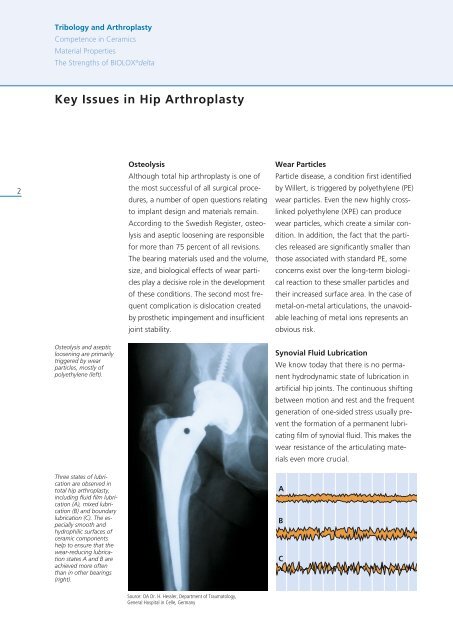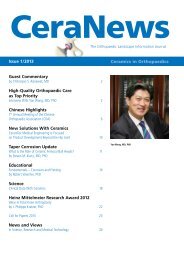BIOLOX - Nanocomposite for Arthoplasty
The Fourth Generation of Ceramics
The Fourth Generation of Ceramics
Create successful ePaper yourself
Turn your PDF publications into a flip-book with our unique Google optimized e-Paper software.
Tribology and Arthroplasty<br />
Competence in Ceramics<br />
Material Properties<br />
The Strengths of <strong>BIOLOX</strong> ® delta<br />
Key Issues in Hip Arthroplasty<br />
2<br />
Osteolysis and aseptic<br />
loosening are primarily<br />
triggered by wear<br />
particles, mostly of<br />
polyethylene (left).<br />
Osteolysis<br />
Although total hip arthroplasty is one of<br />
the most successful of all surgical procedures,<br />
a number of open questions relating<br />
to implant design and materials remain.<br />
According to the Swedish Register, osteolysis<br />
and aseptic loosening are responsible<br />
<strong>for</strong> more than 75 percent of all revisions.<br />
The bearing materials used and the volume,<br />
size, and biological effects of wear particles<br />
play a decisive role in the development<br />
of these conditions. The second most frequent<br />
complication is dislocation created<br />
by prosthetic impingement and insufficient<br />
joint stability.<br />
Wear Particles<br />
Particle disease, a condition first identified<br />
by Willert, is triggered by polyethylene (PE)<br />
wear particles. Even the new highly crosslinked<br />
polyethylene (XPE) can produce<br />
wear particles, which create a similar condition.<br />
In addition, the fact that the particles<br />
released are significantly smaller than<br />
those associated with standard PE, some<br />
concerns exist over the long-term biological<br />
reaction to these smaller particles and<br />
their increased surface area. In the case of<br />
metal-on-metal articulations, the unavoidable<br />
leaching of metal ions represents an<br />
obvious risk.<br />
Synovial Fluid Lubrication<br />
We know today that there is no permanent<br />
hydrodynamic state of lubrication in<br />
artificial hip joints. The continuous shifting<br />
between motion and rest and the frequent<br />
generation of one-sided stress usually prevent<br />
the <strong>for</strong>mation of a permanent lubricating<br />
film of synovial fluid. This makes the<br />
wear resistance of the articulating materials<br />
even more crucial.<br />
Three states of lubrication<br />
are observed in<br />
total hip arthroplasty,<br />
including fluid film lubrication<br />
(A), mixed lubrication<br />
(B) and boundary<br />
lubrication (C). The especially<br />
smooth and<br />
hydrophilic surfaces of<br />
ceramic components<br />
help to ensure that the<br />
wear-reducing lubrication<br />
states A and B are<br />
achieved more often<br />
than in other bearings<br />
(right).<br />
A<br />
B<br />
C<br />
Source: OA Dr. H. Hessler, Department of Traumatology,<br />
General Hospital in Celle, Germany












